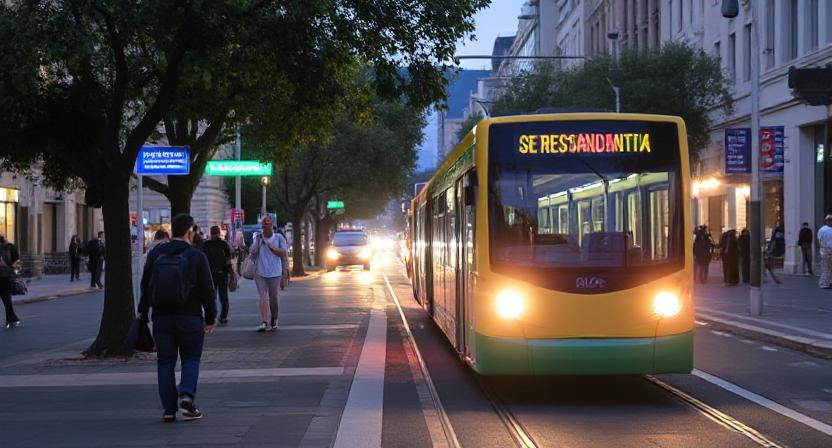Athens and Thessaloniki Enhance Their Visitor Experience with Sustainable Transport Initiatives to Reduce Congestion and Supporting Tourism Growth – Travel And Tour World

Report on Sustainable Urban Mobility Initiatives in Athens and Thessaloniki
Introduction: Enhancing Urban Transport in Alignment with Global Sustainability Goals
This report details the sustainable transport initiatives being implemented in Athens and Thessaloniki. The Greek Ministry of Transport is undertaking measures to reduce traffic congestion and enhance urban mobility by upgrading public transportation networks and introducing sustainable transport modes. These efforts are designed to improve the visitor experience, support tourism growth, and align with the United Nations Sustainable Development Goals (SDGs), particularly those focused on infrastructure, economic growth, and sustainable cities.
Strategic Objectives and Alignment with Sustainable Development Goals (SDGs)
Core Initiatives for Urban Transformation
The primary objective is to provide seamless, ecological, and efficient transport for residents and tourists. The strategy is centered on several key infrastructure projects:
- Expansion of metro systems, including the completion of Metro Line 4 in Athens.
- Introduction of a new fleet of modern, eco-friendly buses.
- Development of integrated smart mobility solutions.
Contribution to SDG 11: Sustainable Cities and Communities
These initiatives directly support the targets of SDG 11 by making urban centers more inclusive, safe, resilient, and sustainable. By providing accessible and efficient public transportation, the projects aim to:
- Reduce traffic congestion and its associated environmental and social costs.
- Improve air quality by promoting a shift from private vehicles to public transit.
- Enhance accessibility to key cultural, historical, and economic hubs for all individuals.
Economic and Infrastructural Impact: Fostering SDGs 8 and 9
Promoting SDG 8: Decent Work and Economic Growth
Improved urban mobility is projected to have a significant positive economic impact on the tourism industry, contributing to SDG 8. The benefits include:
- Increased revenue for hospitality, retail, and local tourism service providers due to higher visitor numbers and spending.
- Greater demand for tour operators, local guides, and transport companies.
- Economic uplift for rural and less-visited areas as improved transport networks encourage regional exploration.
Advancing SDG 9: Industry, Innovation, and Infrastructure
The expansion of metro lines and the modernization of bus fleets represent a substantial investment in resilient and sustainable infrastructure, a cornerstone of SDG 9. These projects enhance the cities’ capacity to manage population and tourist growth efficiently, positioning them as modern, well-connected destinations.
Environmental Responsibility and Climate Action: Addressing SDGs 12 and 13
Championing SDG 12: Responsible Consumption and Production
The focus on sustainable mobility promotes responsible tourism practices, aligning with SDG 12. By offering green transport solutions, Athens and Thessaloniki cater to the growing demand for eco-conscious travel and position themselves as destinations committed to sustainable consumption patterns. Key initiatives include:
- Deployment of electric buses and low-emission vehicles.
- Expansion of bike-sharing programs and pedestrian-friendly zones.
Commitment to SDG 13: Climate Action
These eco-friendly transport initiatives are a critical component of the cities’ climate action strategy, directly addressing SDG 13. By reducing reliance on fossil-fuel-powered vehicles, the projects contribute to a significant reduction in carbon emissions, helping to mitigate climate change and preserve the natural environment in line with European Union sustainability goals.
Long-Term Vision and Collaborative Framework
Enhanced Visitor Experience and Competitiveness
The long-term benefits include a superior and stress-free visitor experience, which increases tourist satisfaction and encourages longer stays. Enhanced connectivity also strengthens the cities’ appeal for MICE (Meetings, Incentives, Conferences, and Exhibitions) tourism, creating a balanced offering of business and leisure opportunities.
The Role of SDG 17: Partnerships for the Goals
The success of these sustainable mobility projects is contingent on robust collaboration, reflecting the principles of SDG 17. Continued partnership is required between:
- Local and national government bodies.
- Private sector transport and technology companies.
- Tourism industry stakeholders, including hotels, tour operators, and cultural institutions.
This collaborative approach is essential for developing integrated ticketing systems, dedicated public transport lanes, and promoting tourism products that emphasize sustainability.
Conclusion: A Future of Sustainable Tourism and Mobility
The ongoing development of sustainable mobility in Athens and Thessaloniki is fundamental to the future of their tourism industries. By integrating eco-friendly transport, smart mobility solutions, and expanded public transit systems, the cities are actively contributing to the Sustainable Development Goals. These efforts will not only enhance their competitiveness in the global tourism market but also ensure long-term economic and environmental sustainability for the region.
Analysis of Sustainable Development Goals in the Article
1. Which SDGs are addressed or connected to the issues highlighted in the article?
-
SDG 8: Decent Work and Economic Growth
- The article connects sustainable transport initiatives directly to tourism growth, which in turn boosts the local economy. It states that improved mobility will have a “significant economic impact on the tourism industry, benefiting hotels, restaurants, local attractions, and transportation providers.” This aligns with SDG 8’s aim to promote sustained, inclusive, and sustainable economic growth.
-
SDG 9: Industry, Innovation and Infrastructure
- The core of the article discusses the development and upgrading of infrastructure. It highlights the “expansion of metro systems” (specifically mentioning Athens’ Metro Line 4) and the “introduction of a new fleet of buses.” This directly relates to SDG 9’s focus on building resilient, sustainable, and innovative infrastructure.
-
SDG 11: Sustainable Cities and Communities
- The initiatives aim to make Athens and Thessaloniki more sustainable and livable by reducing traffic congestion and improving public transport. The article’s goal to “offer seamless and sustainable travel for all” and provide “efficient and accessible public transportation” is central to SDG 11, which seeks to make cities inclusive, safe, resilient, and sustainable.
-
SDG 13: Climate Action
- The article explicitly mentions that the transport initiatives are part of a broader push for sustainability that aligns with “the European Union’s sustainability goals, which emphasize reducing carbon emissions and promoting environmental preservation.” The introduction of “electric buses” and “low-emission vehicles” directly addresses the need to combat climate change, which is the core of SDG 13.
-
SDG 17: Partnerships for the Goals
- The article concludes by emphasizing that the success of these projects depends on “continued collaboration between local governments, the private sector, and tourism stakeholders.” This call for multi-stakeholder partnerships to achieve sustainable development goals is the essence of SDG 17.
2. What specific targets under those SDGs can be identified based on the article’s content?
-
Target 8.9: “By 2030, devise and implement policies to promote sustainable tourism that creates jobs and promotes local culture and products.”
- The article is centered on this target. The “sustainable mobility plan” is a policy designed to make the cities “more attractive and accessible to tourists, with a positive impact on the tourism sector and economic growth.” It also mentions promoting “regional tourism” to ensure “economic benefits are felt more evenly.”
-
Target 9.1: “Develop quality, reliable, sustainable and resilient infrastructure…to support economic development and human well-being, with a focus on affordable and equitable access for all.”
- The “expansion of metro systems” and upgrading of “public transportation networks” are direct examples of developing sustainable infrastructure to support both economic development (tourism) and human well-being (ease of travel for residents and visitors).
-
Target 11.2: “By 2030, provide access to safe, affordable, accessible and sustainable transport systems for all…notably by expanding public transport.”
- This target is directly addressed through the government’s strategy of “improving urban mobility” by expanding the metro and bus systems to provide “efficient and accessible public transportation” for both “local residents and international visitors.”
-
Target 11.6: “By 2030, reduce the adverse per capita environmental impact of cities…”
- The article’s focus on “eco-friendly transport initiatives” such as “electric buses, bike-sharing programs, and low-emission vehicles” is a clear strategy to reduce the environmental impact of the cities, specifically by tackling carbon emissions from transport.
-
Target 13.2: “Integrate climate change measures into national policies, strategies and planning.”
- The commitment by the “Greek Ministry of Transport to introducing more sustainable transport modes” and integrating “sustainability into tourism policies” demonstrates the integration of climate action into national and municipal-level planning.
-
Target 17.17: “Encourage and promote effective public, public-private and civil society partnerships…”
- The article explicitly states that success “will depend on continued collaboration between local governments, the private sector, and tourism stakeholders,” directly mirroring the language and intent of this target.
3. Are there any indicators mentioned or implied in the article that can be used to measure progress towards the identified targets?
-
Indicators for Economic Growth (Target 8.9):
- Increased tourist spending: The article implies this by stating that businesses in “hospitality, retail, and tourism services, stand to benefit from increased spending.”
- Demand for tourism services: Progress could be measured by a “rise in demand” for “tour operators, local guides, and transport companies,” as mentioned in the text.
- Growth in regional tourism: An indicator would be the economic uplift in “rural and less-visited areas” as tourists are encouraged to visit them.
-
Indicators for Infrastructure Development (Target 9.1 & 11.2):
- Expansion of public transport networks: The “completion of Metro Line 4” and the overall “expansion of metro systems” are concrete, measurable infrastructure projects.
- Modernization of vehicle fleets: The “introduction of a new fleet of buses” is a specific indicator of transport upgrades.
- Availability of alternative transport: The number and usage of “bike-sharing programs” can be tracked.
- System efficiency: The implementation of “integrated ticketing systems” is a measurable improvement in accessibility.
-
Indicators for Environmental Impact (Target 11.6 & 13.2):
- Reduction in emissions: The primary goal of “reducing carbon emissions” is a key performance indicator.
- Adoption of green technology: The proportion of the public transport fleet that consists of “electric buses” and “low-emission vehicles” is a clear, quantifiable indicator.
-
Indicators for Partnerships (Target 17.17):
- Formation of collaborations: The establishment of working groups or formal partnerships between “local governments, the private sector, and tourism stakeholders” would be a direct indicator of progress.
4. Summary Table of SDGs, Targets, and Indicators
| SDGs | Targets | Indicators |
|---|---|---|
| SDG 8: Decent Work and Economic Growth | 8.9: Promote sustainable tourism that creates jobs and promotes local culture and products. |
|
| SDG 9: Industry, Innovation and Infrastructure | 9.1: Develop quality, reliable, sustainable and resilient infrastructure. |
|
| SDG 11: Sustainable Cities and Communities |
11.2: Provide access to safe, affordable, accessible and sustainable transport systems for all.
11.6: Reduce the adverse per capita environmental impact of cities. |
|
| SDG 13: Climate Action | 13.2: Integrate climate change measures into national policies, strategies and planning. |
|
| SDG 17: Partnerships for the Goals | 17.17: Encourage and promote effective public, public-private and civil society partnerships. |
|
Source: travelandtourworld.com
What is Your Reaction?
 Like
0
Like
0
 Dislike
0
Dislike
0
 Love
0
Love
0
 Funny
0
Funny
0
 Angry
0
Angry
0
 Sad
0
Sad
0
 Wow
0
Wow
0
















































/environment-climate-change-and-health-(ech)/water-sanitation-hygiene-and-health-(wsh)/landfill-tuvalu-36092.tmb-1200v.jpg?sfvrsn=5c21fe40_1#)

.jpg.webp?itok=0ZsAnae9#)


























